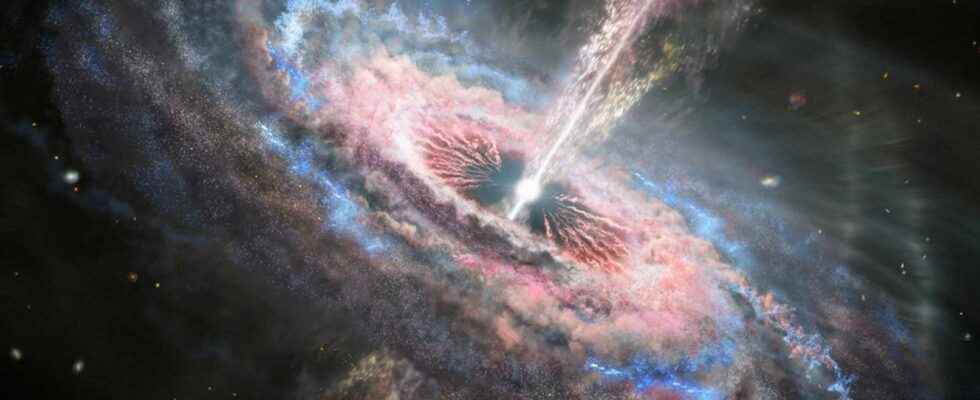Quasars are stars distant, which appear as stars very bright when observed telescopebut which are now known to be examples of so-called active nuclei of galaxies (Active Galactic Nuclei Where AGN, in English), which are not necessarily as luminous as quasars. We have every reason to believe that their prodigious energy comes from the accretion of the matter by rotating supermassive Kerr black holes, which may contain millions to billions of masses solar as M87*, recently imaged by members of the collaboration Event Horizon Telescope.
In this excerpt from the TV-Web-cinema platform “ From the Big Bang to the Living », which covers discoveries in the field of astrophysics and cosmology, Jean-Pierre Luminet tells us about quasars. © Jean-Pierre Luminet
Stars 5 million million times brighter than the Sun
The discovery of quasi-stellar radio sources, ” quasar », according to the name proposed in 1964 by theastrophysicist of Chinese descent Hong Yee Chiustarted from 1963 when Maarten Schmidta astronomer Dutch, published with his colleague John Beverly Oke in the newspaper Nature the results of the observations they had made using in particular the technique of concealments. They sought to determine the optical counterpart of a powerful radio source discovered a few years earlier by another astronomer, Allan Sandage. The source had been named 3C 273, which means it was 273and object of the third Cambridge catalog listing radio sources.
Schmidt and Oke’s article was a hit thunder in the skyastrophysics and some cosmology. The spectral analysis of the star they had identified in the visible in the Virgo Constellation revealed lines ofepisode of hydrogen strongly red-shifted. This meant that what appeared to be a star was outside the Milky Waybut especially at a cosmological distance.
Indeed, 3C 273 was more than 2.4 billion light-years from our Galaxy, which means that to be observable at such a properly cosmological distance, what looked like a star had to be of a brightness absolutely prodigious, exceeding 5 million million times that of the Sunor presented in another way, was equivalent to that of 1,000 times the hundreds of billions of stars in our Milky Way!
This means that 3C 273 would appear almost as bright in the sky as the Sun if it were located in place of the star Pollux, about 10 parsecs only about thirty light-years away.
Quasars and cosmology
This discovery of a quasi-stellar radio source demonstrated that theuniverse was different in the past, and therefore was evolving. This was not possible under the standard cosmological model of the time, according to which, although expanding, the universe should appear unchanged to all its observers, regardless of their position in time. On the other hand, the existence of 3C 273 was in perfect agreement with the theory of the big Bang, since it predicted that if we observed objects at sufficiently large distances, we went back further and further into the past and the history of an evolving universe. It was therefore normal to observe a universe billions of light-years away whose appearance differs from that which it had only a few tens of millions of years ago, therefore in the environment close to the Milky Way .
Are galaxies born from a black hole? Quasars, these supermassive black holes at the heart of galaxies, are they at the origin of the birth of stars before swallowing them? First episode of a collection of web documentaries on astrophysics in the XXIand century. Director: Pierre-François Didek (Karamoja Productions). Collection director: Vincent Minier (AIM Paris-Saclay laboratory). © AstrophysicsTV, Dailymotion
Astrophysicists very early on sought to understand the nature of these stars which, although releasing enormous amounts of energy, seemed to be small in size. It was first thought that they could be huge stars dominated by the effects of general relativity before quickly considering that it could be supermassive black holes accreting large amounts of gas.
In the bestiary of relativistic stars that began to be seriously explored during the 1960s, some, like Igor Novikov and Yuval Ne’eman, even proposed that quasars were actually white holes. That is to say, either regions of the universe whose expansion at the time of big Bang had been delayed (assumption of lagging core) or the other end of wormholes ejecting matter they had absorbed as black holes into another part of the cosmos even in another universe.
You will also be interested
[EN VIDÉO] First image of a supermassive black hole: zoom on the environment of M87* This artist animation depicts a plunge towards a supermassive black hole hidden in a bubble of hot gas. It is surrounded by an accretion disk where the material is so heated that it becomes a very luminous plasma at the origin of jets of material in relation to the rotation of a Kerr black hole. In this case, it is M87*, the supermassive black hole which delivered the first image of such an object in April 2019 thanks to members of the Event Horizon Telescope (EHT) collaboration.
Interested in what you just read?
